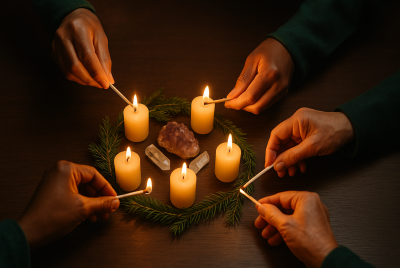How to Start a Gratitude Practice Routine That Sticks
We may earn a commission for purchases made using our links. Please see our disclosure to learn more.
Have you ever considered how frequently we concentrate on the bad things? It’s really simple to focus on the things in our lives that aren’t functioning, isn’t it? However, what if the script could be reversed? You might need a gratitude practice to alter your life. It all comes down to finding the positive aspects of the chaos. We’ll explore how to start a gratitude practice routine in this post that will help you live a more contented and joyful life. So grab your preferred tea or coffee and let’s get going!
What is a Gratitude Practice?
The main idea behind a gratitude practice is to take some time to consider your blessings. Although it seems easy, the impact is profound. It could be something minor, like the additional five minutes of sleep you had this morning, or something major, like being grateful for your family or your health. Regular thankfulness exercises assist you in changing your perspective from what is lacking in your life to what is currently there. The great thing about it is that the more you practice it, the more your mind begins to find reasons to be grateful, even on difficult days.
Why You Should Start a Gratitude Practice
So why all this crap about gratitude? As it happens, there are several really good explanations. To begin with, cultivating thankfulness can improve your mood and lower your stress levels. It’s similar like discovering a button for mental reset. Those who cultivate thankfulness frequently report feeling less stressed and more satisfied. Additionally, you will see improvements in your relationships as you learn to be grateful for the small things in life. Whether it’s a simple remark or a kind word from a buddy, thankfulness adds a little warmth and significance to everything. Who doesn’t want more of it, after all?

Step 1: Set Your Intentions
Consider your motivations for beginning a thankfulness practice before you get started. Perhaps it’s to feel happier? or to enhance your psychological well-being? For whatever reason, making an intention keeps you in check. It’s similar to knowing where you’re going on a road trip. It’s simpler to stay on course and keep going if you know where you’re heading. What is your “why” for beginning this practice, then? You’ll have a clear route ahead once you realize it.
Step 2: Start Small
Alright, here’s the thing: don’t overcomplicate it. You don’t need to carve out a whole hour every day. Start small—just five minutes a day. If you’re someone who struggles with big changes, this is the perfect starting point. Write down three things you’re grateful for, even if they’re small. It could be something as simple as enjoying a warm cup of coffee or feeling the sun on your face. These little wins will keep you motivated, and before you know it, your gratitude practice will feel like second nature.
Step 3: Make it Part of Your Daily Routine
Consistency is the secret sauce to making any habit stick. To make your gratitude practice a daily routine, tie it to something you already do every day. Drink coffee in the morning? That’s a perfect time for a gratitude moment. Maybe you journal at night—add a line or two of gratitude before bed. By attaching your gratitude practice to something that’s already part of your routine, you’ll have less of a chance of forgetting. It’s all about making it easy to remember and harder to skip!
Step 4: Use a Gratitude Journal
If you haven’t tried journaling, now’s the perfect time to give it a shot. A gratitude journal is basically your personal space to jot down everything you’re thankful for. You can write in the morning to kick off your day or at night to reflect. I remember starting mine when I felt overwhelmed with work, and it really helped shift my perspective. It’s like having a little treasure chest where you store all the things that brighten your life. Every time you read back, you’re reminded of just how much you’ve got to be grateful for.
Step 5: Be Specific
One thing I’ve learned from practicing gratitude is that the more specific you are, the more meaningful it feels. Instead of just writing, “I’m grateful for my family,” get specific: “I’m grateful for the way my sister checked in on me today, it really made me feel seen.” Specific gratitude makes the moment more personal and more impactful. Think of it as zooming in on a photograph—you start to notice the little details that make it special.
Step 6: Celebrate Your Wins
A simple “thank you” can do wonders, but don’t forget to celebrate the small wins in your gratitude practice. Every time you reflect on something you’re grateful for, take a moment to acknowledge it. A little internal “high-five” never hurt anyone! Celebrating the small victories keeps your practice alive and exciting, which makes it way easier to keep going. You can even reward yourself with something you love—a favorite snack, a quiet moment of peace, or anything that makes you smile.
Step 7: Share Gratitude With Others
Gratitude doesn’t have to stay between you and your journal. Sharing your gratitude with others can have a huge impact. Ever noticed how it feels when someone thanks you for something you did? That warm feeling is contagious. By expressing gratitude to others, you not only spread joy, but you also reinforce your own gratitude practice. A simple “thanks for being there” can brighten someone’s day and deepen your connection with them. It’s a win-win situation.
Step 8: Practice Gratitude Even During Hard Times
Here’s the kicker: practicing gratitude during tough times is when it really makes a difference. Life’s not always sunshine and rainbows, but gratitude can help you navigate the storms. When I lost my job a couple of years ago, it felt like the world was crashing down. But even in that tough spot, I started noting small things I was thankful for—like having the support of my family or the chance to learn new skills. It didn’t erase the bad stuff, but it sure helped me cope with it better.
Step 9: Use Visual Reminders
Let’s face it, sometimes life gets busy, and we forget to hit the gratitude pause button. One way to stay on track is to use visual reminders. Stick a note on your mirror, put a reminder on your phone, or use a little gratitude app that pings you each day. It’s like having a personal cheerleader reminding you to take a moment and appreciate the good things in your life. These little nudges help keep your practice fresh and consistent.
Step 10: Be Kind to Yourself
You’re human, and humans slip up. Maybe you miss a day or forget to jot down your three things. No biggie. The key here is to be kind to yourself. Don’t let guilt derail your practice. If anything, embrace the bumps along the way and learn from them. Think of it like learning to ride a bike—there are wobbles and falls, but each time, you get a little better at balancing.
Step 11: Track Your Progress
Tracking your progress can be surprisingly motivating. Each time you reflect on something you’re grateful for, jot it down. Not only does it give you a sense of accomplishment, but it also helps you look back on the positive changes over time. You might be surprised at how quickly your mood shifts after a couple of weeks of consistent gratitude practice. It’s like keeping a scoreboard of your own happiness!
Step 12: Integrate Gratitude into Your Meditation or Mindfulness Practice
If you already meditate or practice mindfulness, incorporating gratitude is a no-brainer. After a few minutes of focusing on your breath, try mentally listing things you’re thankful for. It’s a great way to deepen your meditation and bring even more calm into your day. Plus, you’re combining two practices that promote peace and positivity—talk about a win-win!
Step 13: Be Patient and Stay Consistent
Gratitude isn’t a magic switch that instantly transforms your life. It takes time, and you’ll need to stay patient. Don’t expect immediate results or get discouraged if it feels hard at first. The trick is consistency. Over time, just like building a muscle, your gratitude practice will grow stronger and more natural.
Step 14: Experiment With Different Gratitude Practices
If you ever feel like your gratitude practice is getting a little stale, don’t be afraid to mix things up. Maybe try writing a gratitude letter to someone, or even participate in a gratitude challenge on social media. Experimenting with different ways to practice keeps things exciting and helps you stay engaged. After all, the goal is to make gratitude something you genuinely enjoy.
Step 15: Make It a Lifestyle
Eventually, gratitude will become more than just a habit—it will be a lifestyle. You’ll start noticing things you’re grateful for throughout the day, without even trying. It’s like wearing a pair of rose-colored glasses—you begin to see the beauty in the everyday moments. Once you integrate gratitude into your life, it’s hard to imagine living without it.

Popular products that can enhance your gratitude practice
The One-Minute Gratitude Journal
Designed for those with limited time, this journal offers quick prompts to cultivate a daily gratitude habit.
Gratitude Journal for Men: A Daily 5 Minute Guide for Mindfulness, Positivity, Leadership, and Self Care
Tailored for men, this journal provides structured prompts to foster gratitude and personal growth.
The Five Minute Journal
A popular choice that encourages daily reflection with prompts for gratitude, affirmations, and highlights of the day.
The 6 Minute Diary
This journal combines positive psychology principles with daily prompts, aiming to boost happiness and mindfulness in just six minutes a day.
Gratitude Journal: 6 Months Daily Journal with Prompts and Quotes for Happiness, Mindfulness, Reflection & Self Care
Offering a six-month guided journey, this journal includes daily prompts and inspirational quotes to support your gratitude practice.
Benefits of Gratitude on Emotional and Physical Health
Scientific research consistently shows that practicing gratitude can have significant benefits for both emotional and physical well-being. According to a study on the emotional benefits of gratitude, regularly acknowledging things you’re thankful for is associated with increased happiness and reduced depression. This simple practice can have a profound impact on your mental health by shifting focus to the positive aspects of life. Additionally, gratitude has been linked to better heart health, with studies suggesting that expressing gratitude can help reduce risk factors associated with heart disease. For more insights into how gratitude affects emotional well-being, check out this Harvard Health article on gratitude and happiness. Similarly, UCLA’s research discusses how gratitude can improve cardiovascular health, which you can explore in more detail in this UCLA Health article.
Conclusion: The Power of Gratitude
Gratitude is more than just a feel-good practice; it’s a powerful tool that can change the way you see the world. By following the steps above, you’ll be well on your way to creating a gratitude routine that sticks. And the best part? It’s not about perfection—it’s about progress. So, take it one day at a time, and let gratitude transform your life, one small moment at a time.
FAQs
- How long does it take to develop a gratitude habit? It usually takes around 21 to 30 days to form a habit, but everyone’s different. Just keep at it, and soon enough, gratitude will feel like second nature.
- Can I practice gratitude even when I’m feeling down? Yes! Gratitude is especially powerful during hard times. It won’t make everything better, but it will help you shift your focus to what’s still good in your life.
- How do I stay consistent with my gratitude practice? Attach your practice to something you already do every day, set reminders, and celebrate your wins. Over time, consistency becomes much easier.
- Can gratitude really improve my mental health? Absolutely! Gratitude has been shown to reduce stress, anxiety, and depression, while boosting happiness and overall well-being.
- What if I don’t know what to be grateful for? Start small. Even on tough days, focus on simple things like your breath, the food you’re eating, or a kind word from a friend. Gratitude can be found in the smallest of moments.




